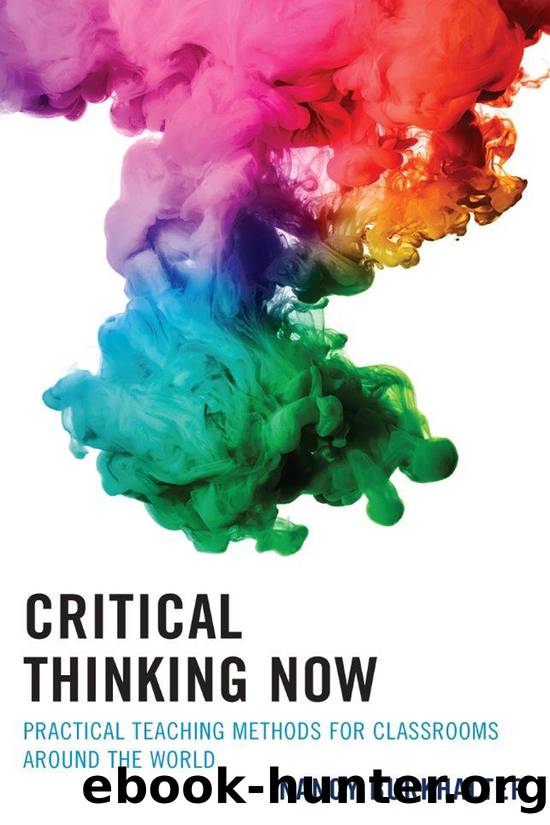Critical Thinking Now by Burkhalter Nancy;

Author:Burkhalter, Nancy;
Language: eng
Format: epub
Publisher: Rowman & Littlefield Unlimited Model
Chapter 4
Assessing Critical Thinking
Consider this question: Should testing methods dictate how you teach? Seems a bit backward, doesnât it? This approach sounds like Procrustes, the mythological Greek blacksmith, who either stretched people or cut off their legs to make them fit the iron bed heâd created. When it comes to testing, it seems more logical and sensible to use effective teaching methods and then devise ways to measure learning. Better yet, why not have testing serve a dual purposeâto both measure and enhance critical thinking? And itâs not even hard to do.
To accomplish these two goals, you need to create a transparent, focused, easy-to-use, performance-based exercise and an instrument showing whether students have learned the material, where they need to improve, and what they need to do to get a better grade. Below are some items to think about when it comes to assessment to be expanded upon later:
⢠When to assess: At the beginning, middle, or end of instruction,
⢠Which format: Oral, written, or online,
⢠Who assesses: Teacher or student, together or alone,
⢠Which instruments: Rubric, holistic scoring, self-assessment, and
⢠What to assess: Essay, presentation, debate performance, play, mock trial, class or group participation, poem, outline of a paperâwhatever needs to be checked for understanding or proficiency.
When it comes to critical thinking, trueâfalse and multiple-choice tests may serve to generate numbers for your gradebook, but they donât reflect deep understanding because they measure only the lowest-level cognitive activities of remembering and possibly comprehending. Moreover, they take time away from real learning. It doesnât matter whether a student knows that the Civil War lasted four years or can identify South Sudan as the newest country. It doesnât mean anything.
So, letâs see how learning and testing can be fast friends when it comes to critical thinking. This chapter unpacks that alliance by discussing how, when, and why you should test, and finally, how these practices contribute to critical thinking. First, though, is a brief discussion of the two different ways of testing.
Formative versus Summative Testing
Simply put, formative assessments occur throughout the instructional period, whereas summative tests look back at what a student has accomplished by the end of the course or unit.
Formative assessments can consist of:
⢠Short pop quizzes,
⢠Journals,
⢠Impromptu responses to your questions,
⢠Drafts and revisions of writing,
⢠Class discussion about a reading or theory, and
⢠Reflections.
Summative tests include:
⢠Standardized placement and achievement tests (ACT, SAT, TOEFL, LSAT, MCAT, GRE),
⢠Final exams,
⢠Presentations, and
⢠Final papers.
Summative tests generate scores that reveal little about the test takersâ understanding of the material and provide no chance to challenge or clarify an answer. Whereas summative tests are a snapshot of a studentâs knowledge base, formative assessments are a video, whose script can be edited before finalizing production. Both kinds measure learning, but formative assessments have these important advantages:
⢠You see how they are doing before instruction ends so you can tweak the lesson if they donât understand something.
⢠They see how they are doing and can retool their thinking and performance.
Whatâs more, in terms of critical thinking, formative assessment helps learners reflect, question, analyze, evaluate, make connections, and summarize information.
Download
This site does not store any files on its server. We only index and link to content provided by other sites. Please contact the content providers to delete copyright contents if any and email us, we'll remove relevant links or contents immediately.
The Art of Coaching Workbook by Elena Aguilar(50168)
Trainspotting by Irvine Welsh(21078)
Twilight of the Idols With the Antichrist and Ecce Homo by Friedrich Nietzsche(18324)
The Secret History by Donna Tartt(18268)
All the Missing Girls by Megan Miranda(14858)
Cat's cradle by Kurt Vonnegut(14804)
Ready Player One by Cline Ernest(14062)
Talking to Strangers by Malcolm Gladwell(12916)
Fangirl by Rainbow Rowell(8819)
The Compound Effect by Darren Hardy(8544)
Thirteen Reasons Why by Jay Asher(8492)
The remains of the day by Kazuo Ishiguro(8433)
Periodization Training for Sports by Tudor Bompa(7947)
Tools of Titans by Timothy Ferriss(7850)
Wonder by R. J. Palacio(7756)
The Lover by Duras Marguerite(7605)
Change Your Questions, Change Your Life by Marilee Adams(7405)
A Court of Wings and Ruin by Sarah J. Maas(7307)
The Complete Stick Figure Physics Tutorials by Allen Sarah(7162)
